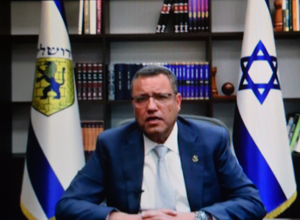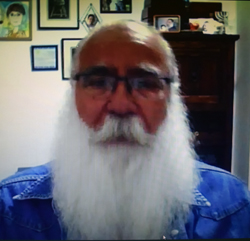
Other items in today’s column include:
*Jewish American Heritage Month


SAN DIEGO – Traditionally, the Memorial Day weekend is one of the busiest of the year for travelers, but not so in 2020 because of the coronavirus pandemic. However, technology, in the form of a Zoom meeting, whisked me on Sunday, May 24, from my home in San Diego and on to a tri-religious journey to Jerusalem, under the auspices of the America Israel Friendship League (AIFL).
On the Hebrew calendar, this is the same week as the one in 1967 when Jerusalem was reunited during the Six Day War, prompting the city’s current mayor, Moshe Lion, to promise that the city will always remain united “as a place of faith, culture, innovation and trade.” Deputy Mayor Fleure Hassan-Nahoum, in her greeting to viewers, called Jerusalem a capital for all the people, dear to all three faiths of Judaism, Christianity, and Islam.

Thereupon, veteran guide Reuven Solomon, using slides, reviewed the history of the city from the time that Abraham took Isaac up to Mount Moriah, where God tested his faith, to the time of the Six Day War and the breathtaking moment when Israeli soldiers prayed together at the recaptured Western Wall. He reviewed not only the Jewish history of the city, but also that of Christianity and Islam, the latter particularly appropriate as the Zoomcast fell on the last day of the month of Ramadan, when Muslims fast during daytime hours and hold Iftar meals in the evening.
In King David’s time, said Solomon, Jerusalem was the home of the Jebusites, an independent people. Their city was on a small stretch of land that had not been allocated to any of the 12 Israelite tribes. Needing a neutral place to build his capital – much like Washington D.C. thousands of years later was built as an independent city, not belonging to any of the states – David conquered the Jebusites, and purchased the land for the Temple north of the city from a Jebusite landowner. However, God granted David’s son King Solomon the right to build the First Temple on that spot, believed to be the very same hilltop where Abraham had been prepared to sacrifice Isaac.
After Solomon’s rule, ten tribes split off from Judea forming the northern kingdoms that were defeated and their people scattered by the Assyrians. Because Jerusalem was fortified, the Assyrians chose not to attack it, but years later, the Babylonians, under King Nebuchadnezzar, destroyed Jerusalem and the First Temple, moving many Judeans en masse to Babylon (today’s Iraq), where by the Rivers of Babylon, according to Psalm 137, they pledged “If I forget you, O Jerusalem, let my right hand forget its skill.” That said, Reuven Solomon, was the very first expression of Zionism. Eventually King Cyrus the Great conquered the Babylonians, permitting the Judeans to return to Jerusalem and rebuild the temple. But before long Jerusalem was conquered by Alexander the Great.
His general Seleucid, attempting to convert the Judeans to Greek style worship, desecrate the Temple, prompting the Maccabean revolt that is celebrated at Chanukah. Miraculously the small band of freedom fighters led by Judah Maccabee defeated the more powerful Greek army and the Hasmonean dynasty began a period of rule. But branches of the family fought each other for control, and the Roman general Pompey was invited in to bring about order. Thus began the Roman period of rule, during which a Jewish king appointed by the Romans, Herod the Great, refurbished the Second Temple. At the end of his reign, Jesus was born in Bethlehem, and under Herod’s successors preached and was crucified. Years later Simon Bar Kochba launched a revolt that was brutally put down by the Romans, who destroyed the Second Temple, renamed Judea as Palestinia, and Jerusalem as Aelia Capitolina. This marked the beginning of the Jewish Diaspora from Jerusalem, although small communities of Jews remained in the land even through wars and conquests by Muslims, Christian Crusaders, Mamaluks, Ottomans. Their numbers were supplemented in the late 19th and early 20th centuries by Eastern European Zionists who sought to return to their homeland. Following World War I, the League of Nations assigned to Britain the responsibility of administering Palestine, which had been captured from the Ottoman Turks. Britain did so until Israel’s Declaration of Independence on May 14, 1948.
Moving to the Christian history, Reuven Solomon pointed out that Jesus referred to the Temple Mount as the Holy of Holies. He flashed a slide of the Byzantine-style Church of All Nations, built at a site believed to be the Garden of Gethsemane, where Jesus spent his final night before his capture. From there, Solomon showed slides of each of the 14 Stations of the Cross, marking the spots in tradition where Jesus was condemned; flagellated and tortured with a crowns; where he fell under the weight of the cross; where he met his mother Mary; where Simon of Cyrene helped him carry the cross; where Veronica wiped his brow; where he fell a second time; where he met weeping women; where he fell a third time; where he was stripped of his clothing; where he was nailed to the cross; where his cross was put upright between those bearing two thieves; where he was taken down from the cross; and where he was placed in a sepulcher. Solomon noted that different Christian sects do not agree on the location of all these stations, so, for example, there are alternative theories on the location of the tomb, from which Christians believe Jesus was resurrected.
The relationship of Islam to Jerusalem is based on accounts in the Hadith, which is a commentary on the Quran – much as the Talmud is a commentary on the Torah. The Hadith’s account is that in 610 CE, Mohammed traveled on a Night Ride to a “Distant Mosque” (Al Aqsa) from which he ascended to heaven where he met Abraham, Moses and Jesus, and then returned to earth with the Quran. Subsequently, the Al Aqsa Mosque was built on top of what Reuven Solomon described as “a hollow entrance” to the destroyed Second Temple. The Golden Dome of the Rock which stands nearby is not a mosque, but a monument, located at the place where the Holy of Holies of the Temple stood, and where it is believed Abraham took Isaac for the Akedah. Together, the Al Aqsa Mosque and Dome of the Rock are considered the third-most holy venue in Islam, behind the holy places of Mecca and Medina in Saudi Arabia.
Reuven Solomon said there are times in Jerusalem when one can hear the bells of Christian churches ringing, the muezzin calling faithful Muslims to prayer, and the shofar sounding for Jews, all together in what he described as a beautiful harmony.
*
Jewish American Heritage Month
Endowment for Middle East Truth (EMET) on May 24 honored Olympic swimmer Mark Spitz, who won seven gold medals during the 1972 Summer Olympics in Munich, Germany.
*
Donald H. Harrison is editor of San Diego Jewish World. He may be contacted via donald.harrison@sdjewishworld.com
Pingback: Zooming through Jerusalem's religious sites - San Diego Jewish World | Bible Prophecy In The Daily Headlines